方案详情文
智能文字提取功能测试中
View Article OnlineView Journal|View Issue View Article OnlineRSC AdvancesPaper Check for updates oooooeoooa Cite this: RSC Adv., 2018, 8,3564 Received 6th October 2017Accepted 31st December 2017 DOI: 10.1039/c7ra11015drsc.li/rsc-advances Evaluation of the taste-masking effects of (2-hydroxypropyl)-B-cyclodextrin on ranitidinehydrochloride; a combined biosensor,spectroscopic and molecular modellingassessmentt Sai Kin Chay,D)a Alison V. Keating,Colin James, Abil E. Aliev, Shozeb Haider aand Duncan Q. M. Craiggiip*a Taste assessment in an increasingly important aspect of formulation development, particularly for paediatricmedications. Electronic taste sensing systems have the potential to offer a rapid, objective and safe methodof taste assessment prior to the use of more costly human panels or animal models. In this study, the abilityof the TS-5000Z taste sensing system to assess the taste masking efficiency of (2-hydroxypropyl)--cyclodextrin (HP-B-CyD) complexes with ranitidine hydrochloride was evaluated in order to explore thepotential of the biosensor approach as a means of assessing taste masking by inclusion complexation.Nuclear magnetic resonance (NMR) spectroscopy and molecular docking studies were employed toidentify and examine the interaction between ranitidine hydrochloride and HP-B-CyD. Taste-maskingefficiencies were determined by the Euclidean distance between taste-masked formulations and thepure drug substance on a PCA score plot. The results showed that with increasing molarity of HP-B-CyDin the formulation, the distance from ranitidine hydrochloride increased, thus indicating a significantdifference between the taste of the formulation and that of the pure drug. NMR studies also providedstrong supporting evidence for the complexation between HP-β-CyD and ranitidine hydrochloride, withthe H3' region of the former identified as the most likely binding site for the drug. Molecular dockingstudies suggested that the dimethylamino and diamine groups of the drug form direct hydrogen bondswith the hydroxyl oxygen atoms of HP-B-CyD, while the furan ring docks in close proximity to H3'. Thisstudy has demonstrated that the biosensor system may provide quantitative data to assess bitterness ofinclusion complexes with HP-B-CyD, while spectroscopic and modelling studies may providea mechanistic explanation for the taste masking process. This in turn suggests that there is a role forbiosensor approaches in providing early screening for taste masking using inclusion complexation andthat the combination with mechanistic studies may provide insights into the molecular basis of taste andtaste masking. Introduction Taste is often a key factor in the development of pharmaceuticalformulations, particularly for paediatric and elderly patients,due to the associated direct influence on patient adherence.The five specific tastes include saltiness, sourness, bitterness,sweetness and umami; bitterness is the most problematic forpharmaceutical formulations due to its intuitive association ( "University College London School o f P harmacy, 29-39 B r unswick Square, L o ndonWC1N 1AX, UK. E-mail: duncan.craig@ucl.ac.uk ) ( University College London Department of Chemistry, 20 Gordon Street, London WC1H0AJ, UK ) ( t Electronic supplementary information (ESI) available. See DOI: 10.1039/c7ra11015d ) with toxicity. The sensory mechanism of signal transductionfollowing binding of a molecule to a taste receptor variesdepending on the taste in question. For example, saltiness ismediated by sodium ion flux through apical sodium channels,sourness is mediated through a hydrogen ion blockade ofpotassium or sodium channels while sweetness and bitternessare transmitted via G protein-coupled receptors,’ with theperception of bitterness being mediated by bitter taste receptors(T2Rs) in the oral cavity.’ Ranitidine hydrochloride (Fig.1) is an H-receptor antago-nist that reduces acid production in the stomach and iscommonly used to treat gastrointestinal diseases such asduodenal ulcer, reflux oesophagitis and Zollinger-EllisonSyndrome. It is included on the World Health Organisation'sList of Essential Medicines which specifies medicines required Fig. 1 Chemical structure of (a) (2-hydroxypropyl)-β-cyclodextrin(with protons numbered); (b) ranitidine HCl. for basic healthcare. However, ranitidine hydrochloride is alsoknown to have a bitter taste and a sulphur-like odour. Thesemay potentially be significant barriers to patient adherence,hence the exploration of taste-masking approaches is of rele-vance for this drug. There are various taste-masking techniques which may beused to inhibit bitter taste.For solid oral dosage forms, poly-mer coating of capsules and tablets or monolithic systems suchas polymer or lipid extrudates may be used;these approachesmay be of less use for paediatric patients for whom swallowingsolid dosage forms can be challenging. Liquid formulationapproaches may include chemical modifications to the drug,microencapsulation, or simply the addition of taste maskingexcipients suchass sugars,. sweeteners andsweetnessenhancers. Complexation by cyclodextrins or ion exchangeresins can also be considered. Cyclodextrins (CDs) belong toa class of cyclic oligosaccharides composed of a-D-glycopyr-anose units linked by a-1,4 glycosidic bonds. The a-,β- and y-cyclodextrins are widely used examples of, with six, seven andeight p-glycopyranose units, respectively. Cyclodextrins exhibita central cavity lined with carbon and oxygen atoms of theglucose residues and a hydrophilic exterior made up of alco-holic hydroxyl groups. As a result, cyclodextrins possess theability to include guest molecule inside their cavities, forminginclusion complexes. These inclusion complexes can enhancedrug solubility, mask bitter taste ofthe active pharmaceuticalingredient (API) and prevent degradation of drug molecules.'(2-Hydroxypropyl)-B-cyclodextrin (HP-B-CyD),a hydroxyalkylderivative of B-CD (Fig. 1), was introduced to improve aqueoussolubility of B-CD as well as to enhance inclusion capability.This chemically modified derivative of β-CD has also displayedan enhanced safety profile compared to its parent compound." The three main approaches to taste-masking assessment arehuman taste panels, animal models and in vitro analyticaltechniques. Taste assessment by a human panel is challengingwith regards to cost, time and unknown toxicity status of newdrug entities. Moreover, the approach is susceptible to varia-tions in the physiology of both the various patient populationsand the individuals concerned. Animal models such as therodent BATA model have also shown great promise in assessing the taste of APIs with comparable results to human taste paneldata, however further validation work is still needed.12,13 In vitroanalytical techniques include the use of dissolution testing andelectronic taste sensing systems. Dissolution testing detects theamount of free drug in a solution as a function of time but isa crude indication of the experience of taste.14 Electronic tastesensing systems are composed of multichannel taste sensors,involving a series of lipid/polymer membrane coatings.15 Thesemultichannel sensors measure a pattern of signals associatedwith the membrane potentials which may then be associatedwith taste quality.16,17 These systems therefore have the poten-tial to offer an objective and safe method for taste-maskingassessment, although validation remains a matter of ongoinginvestigation.18 The two most commonly used, commerciallyavailable taste-sensing systems are Alpha Astree II (Alpha MOS,Toulouse, France) and TS-5000Z (Insent Inc., Atsugi-shi, Japan);in this study, the latter was used. The taste sensing system ismade up of a working electrode with a lipid/polymer membraneused to detect taste substances, a handle and a data processingunit. The system is designed to detect taste in a similar manner tohuman gustatory sensation where lipid/polymer membranes,transducer and statistical analysis in the system mirror the tastebuds, neural transmission and cognition in the thalamus inhumans respectively. Taste substances cause changes in electriccharge density of the lipid/membrane surface and/or iondistribution near the surface of the membrane.19 The totalelectric change is then given as the response membrane electricpotential for the substances. While most studies exploring theuse of taste sensors for pharmaceuticals have focused onassessing the quantitative response for particular drug systems,there is an emerging emphasis on looking at how the approachmay be used to assess taste masking strategies. In particular,a previous investigation has compared the ability of the etongue approach with an animal model to assess cyclodextrin asa means of taste masking praziquantel.20 The rationale for using an electronic taste sensing system todetermine taste-masking effects is that it enables one tomeasure the activity of molecules within a formulation based onits non-specific multi-sensor approach. In addition, the sensorsare able to interact with different chemical structures, whichallows one to assume an overall impression rather than todetermine the concentration of the drug substance. If a (log-linear) dependency between concentrations of the bittertasting drug substance and the sensor response exists, goodresults for the determination of taste-masking properties can beexpected. Since the underlying measurement principle ispotentiometric, sensor responses will most likely be derivedfrom charged molecules. Therefore, it is reasonable to deducethat any reduction in sensor response is based on a lowerexposure to the drug substance due to the taste-maskingapproach in question.21 In this study we have explored the potential of the approachto recognize the role of inclusion complexation as a means ofmasking taste in relation to the complexation process itself. Inparticular, we evaluate the effectiveness of HP-B-CyD to reducethe (measured) bitterness of ranitidine hydrochloride in relation to the complex formation process, as assessed usingnuclear magnetic resonance spectroscopy (NMR); we alsoinvestigate molecular docking studies ofranitidine complexa-tion with HP-B-CyD in order to obtain some basic informationon the likely configuration of any such complex. In this mannerwe intend to correlate (or otherwise) the measured assessmentof taste with the structure of the associated complex, therebyfacilitating the use of the biosensor approach to provide anearly, inexpensive evaluation of complex-based taste-maskingapproaches. Materials and methods Materials Ranitidine:hydrochloride,(2-hydroxypropyl)-β-cyclodextrin,quinine hydrochloride dihydrate, potassium chloride, tartaricacid, potassium hydroxide, hydrochloric acid (32%) werepurchased from Sigma-Aldrich Chemie GmbH (Steinheim,Germany). Absolute ethanol was purchased from Fisherchemical (Geel, Belgium). The inner solution (3.33 mol 1potassium chloride in saturated silver chloride) for sensors andreference electrodes of the taste sensing system was provided byInsent Inc. (Atsugi-shi, Japan). Electronic tongue measurements The Insent TS-5000Z electronic tongue (Insent Ine., Atsugi-shi,Japan) was equipped with four lipid membrane sensors andtwo corresponding reference electrodes; three represent bitter-ness(SB2AC0, SB2AN0 and SB2C00) and one representsastringency (SB2AE1). SB2AC0 is dedicated to bitter cationicsubstances, SB2AN0 is dedicated to bitter cationic and neutralsubstanceswhile SB2c00) ilsSdedicated tobitter anionicsubstances.Each of these sensors was filled with 0.2 ml of innersolution, while the reference electrodes were filled with 0.4 mlof inner solution. All sensors were immersed in standard solu-tion (see below) for 24hours aspreconditioning beforemeasurement. Two washing solutions for negatively and positively chargedsensors were prepared respectively. For the negatively chargedsensors, 30% ethanol in distilled water with 100 mM of hydro-chloric acid was used, while for the positively charged sensors,100 mM of potassium chloride with 10 mM potassiumhydroxide were added to 30% ethanol. The standard solutionserving as cleaning and reference solution was prepared bydissolving 0.3 mM tartaric acid and 30 mM potassium chloridein distilled water. Sensor checks were carried out before every measurement toensure the sensors were working in the correct mV range; eachsample was measured four times. The first run was discarded asrecommended by the supplier to allow for sensor conditioning.The assessment cycle consisted of measuring the referencesolution (V), the sample solution (V ), a short cleaning proce-dure (2 ×3 s), measurement of the after taste (Vr) and finallyfollowed by a cleaning procedure for 330 s. The sensor outputfor taste, also called relative value (R) was determined with respect to the initial measured sensor response to the referencesolution (V.). Test solutions Six different concentrations of ranitidine hydrochloride solu-tions, (between 0.06 mg ml-and 1.50 mg ml-1) were preparedin distilled water. Quinine hydrochloride dihydrate (molecularmass = 396.91 g mol) and HP-B-CyD (molecular mass =~1380g mol-1) solutions were prepared in the same molarity asthe ranitidine hydrochloride (molecular mass=350.86gmol-)solutions so to allow for better comparability (Table S1t). Five taste-masked formulations with different molar ratios ofranitidine hydrochloride to HP-B-CyD(1:1,1:2,1:3,1:4and1:5) were prepared by mixing ranitidine hydrochloride powderwith increasing amount of HP-B-CyD. The concentrations of HP-β-CyD in each of these taste-masked formulations are given inTable S2.t Data analysis In the assessment of taste-masking properties, the sensorsignals of the taste-masked formulations are compared withthat of the pure drug solution using principal componentanalysis (PCA). PCA aims to summarize and reduce multidi-mensional data by transforming sensor signals to principalcomponents, in order to describe the measured formulationsamples in a new space with fewer dimensions. The PCA map ispresented in a two-dimensional graph with the discriminatingfactors as principal component 1 (PC1) on the x-axes andprincipal component 2 (PC2) on the y-axes. As a result, the PCAmap can be evaluated visually by the location of the measuredsamples. Since the pure drug solution exhibits a knownunpleasant bitter taste, the larger the distance between the puredrug and the formulations, the greater the difference in taste.This distance between measured samples, known as Euclideandistances, can be calculated by equation shown in (2), where pand q represent the samples and n is the number of variablesused for the model.2 Data processing, graphical representationand statistical interpretation of results were performed usingOriginPro 2016 (OriginLab, Northampton, MA, USA). NMR studies Solutions of samples were prepared in 99.96% D20 (CambridgeIsotope Laboratories). In the first instance, H-NMR spectra ofHP-B-CyD and ranitidine hydrochloride were recorded sepa-rately. In order to examine the complexation process betweenranitidine hydrochloride and HP-B-CyD in solution, two stocksolutions of 40 mM were prepared. Based on these two equi-molar solutions, three samples containing both ranitidinehydrochloride and HP-B-CyD were prepared. This was achieved by mixing the two solutions at varying proportions, so thata range (0
-
1/10
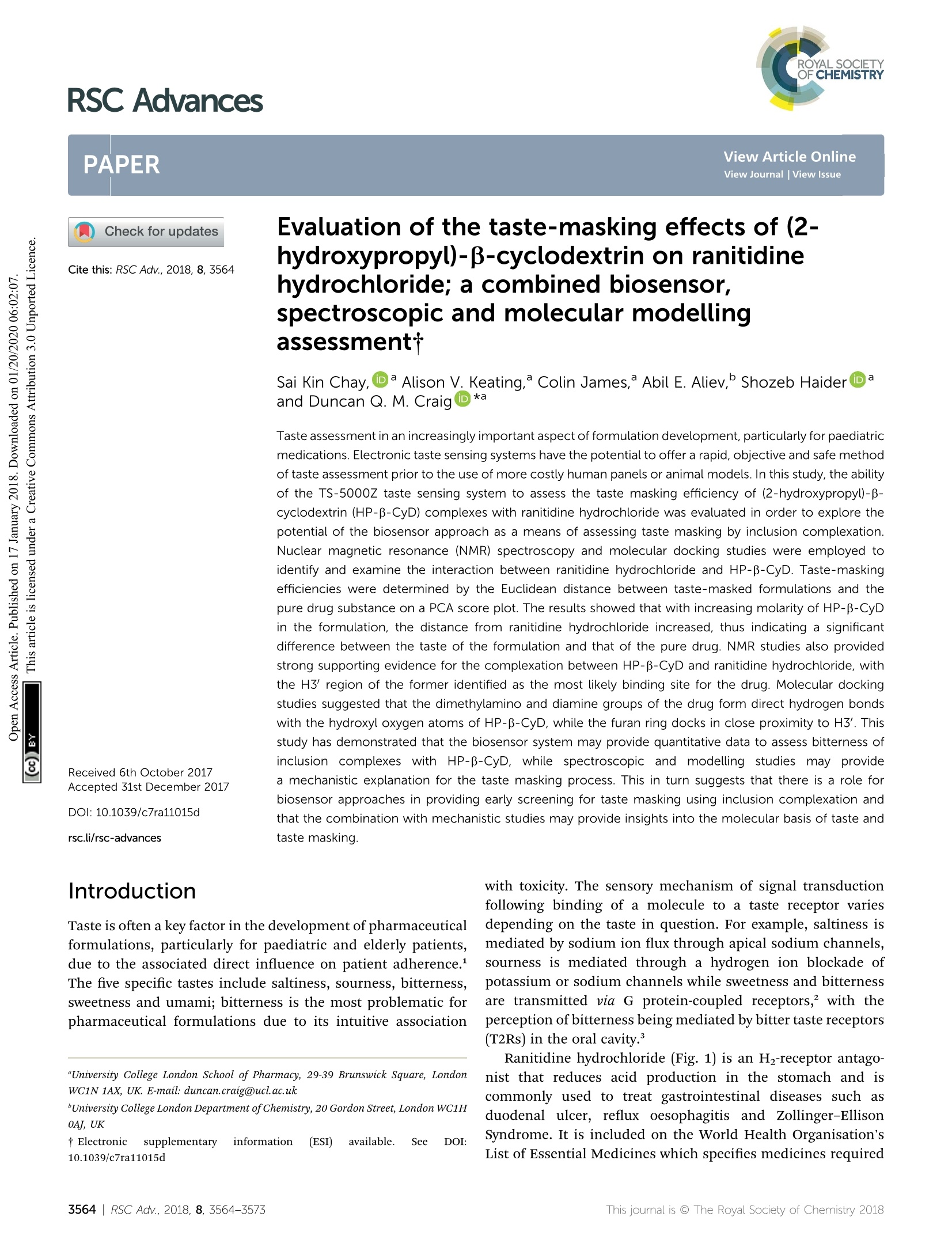
-
2/10
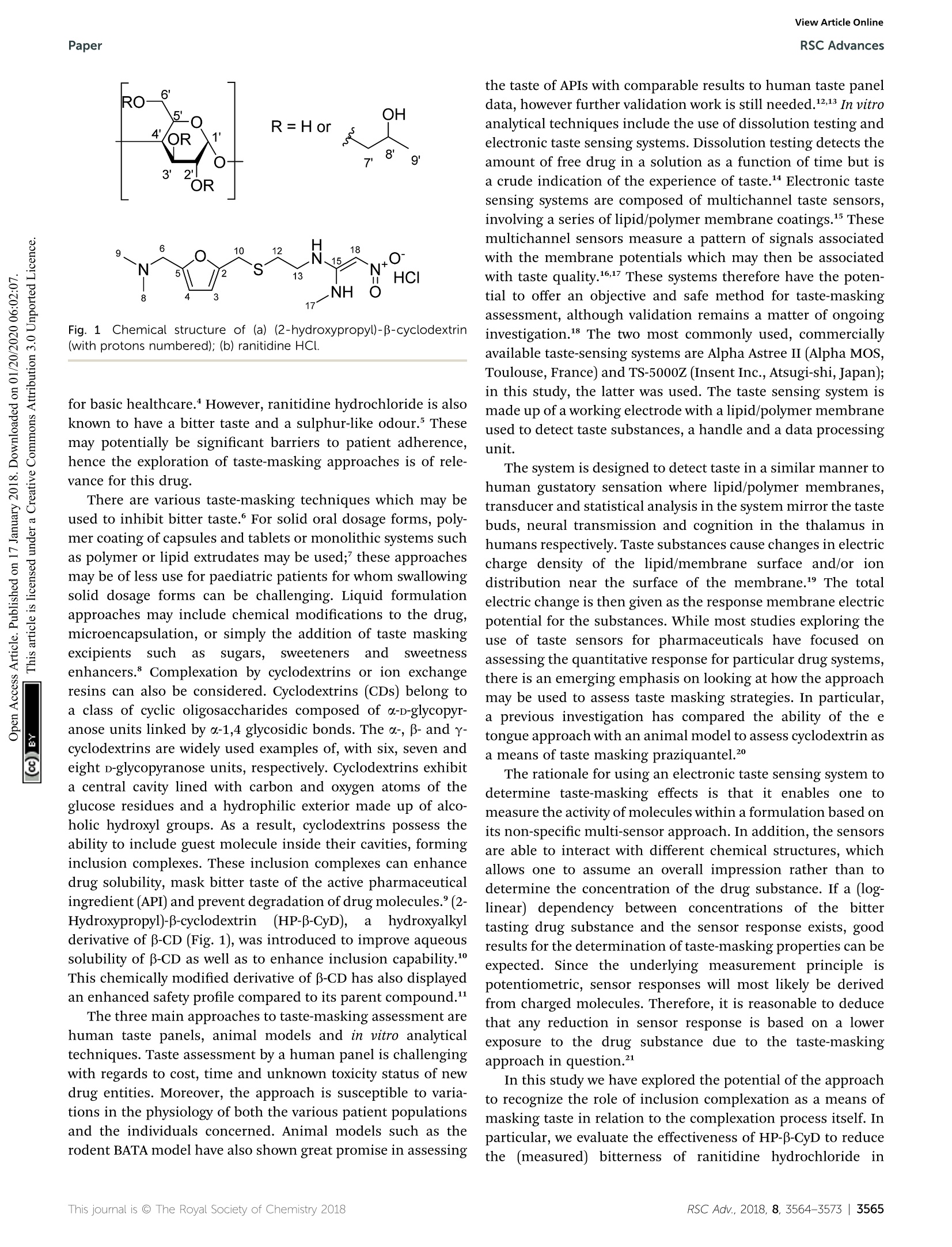
还剩8页未读,是否继续阅读?
继续免费阅读全文产品配置单
北京盈盛恒泰科技有限责任公司为您提供《盐酸雷尼替丁中味觉掩蔽作用检测方案(感官智能分析)》,该方案主要用于化药制剂中其他检测,参考标准《暂无》,《盐酸雷尼替丁中味觉掩蔽作用检测方案(感官智能分析)》用到的仪器有日本INSENT味觉分析系统(电子舌)。
我要纠错
推荐专场
感官智能分析系统(电子鼻/电子舌)
更多相关方案


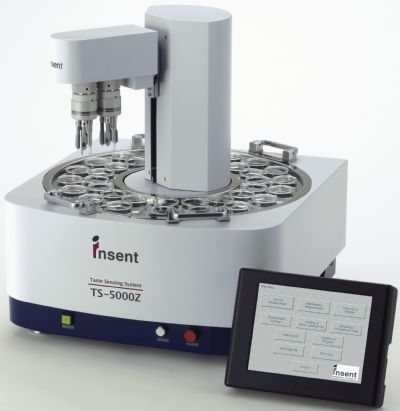
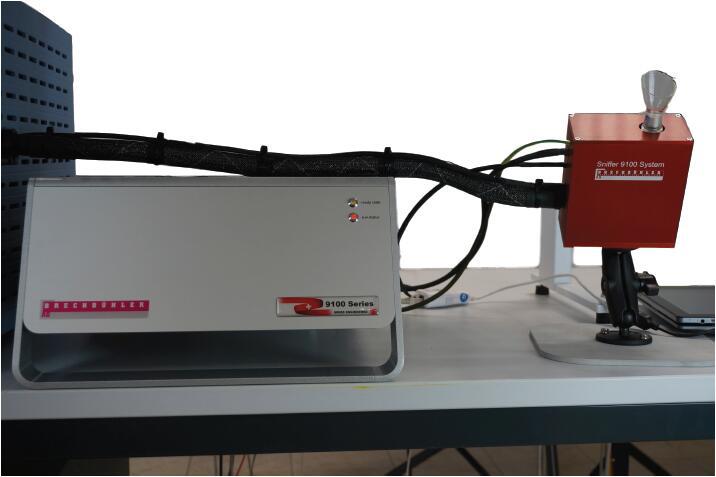
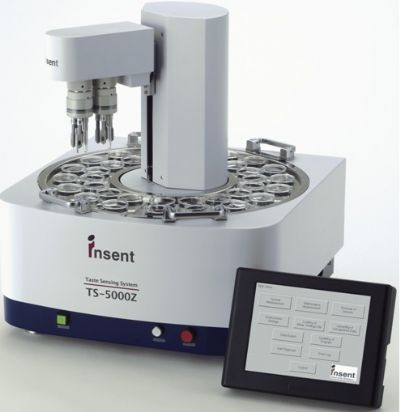
 咨询
咨询





